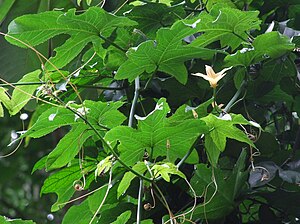Coccinia grandiflora
| Coccinia grandiflora | ||||||||||||
|---|---|---|---|---|---|---|---|---|---|---|---|---|

Female plant of Coccinia grandiflora |
||||||||||||
| Systematics | ||||||||||||
|
||||||||||||
| Scientific name | ||||||||||||
| Coccinia grandiflora | ||||||||||||
| Cogn. |
Coccinia grandiflora is a type of plant from the cucurbitaceae family from East Africa.
features
Coccinia grandiflora is a perennial herbaceous climbing plant with up to 20 m long stem axes . The leaves are alternate, have a 2.5 to 13 cm long stem and are simple. The leaf blade is 12 to 20 inches long and 11 to 20 inches wide and often lobed palmate. The stem, petiole and leaves are usually bare, but in high altitude specimens, soft white hairs may appear on the stem and the underside of the petiole and leaf. Coccinia grandiflora has unevenly divided tendrils. Probracts up to 5 mm long are at the nodes .
The species is dioecious separately sexed ( diocesan ). The flowers very rarely available in both sexes usually solitary in leaf axils, in few-flowered clusters. Flowers are five-fold and the calyx and crown are each and fused together. The lobes of the calyx are 4 to 13 mm long. The corolla is 4 to 6 cm long and apricot to cream colored. The three stamens are fused into a column with a spherical anthers head .
The ovary has three parts, inferior and carries numerous ovules. There is a stylus with three bilobed stigmas . In female flowers there are three small sterile stamens (staminodes).
The fruit is a fleshy, (scarlet) red armored berry 30 cm long and cylindrical in shape. It is around 2 to 4 cm in diameter.
distribution
The species is particularly widespread in the lowland rainforests and East Africa, occasionally also in lower elevations of mountain rainforests and in deciduous forests that have emerged from degraded forests. It occurs between 30 and 1900 m altitude in southeast Kenya , Tanzania and in the mountains of Malawi and between Zimbabwe and Mozambique .
use
There are different statements about the use of the species. Sometimes it is called poisonous, sometimes as edible. Some of the cooked leaves are also used against fever.
Systematics and evolution
According to molecular analyzes, Coccinia grandiflora is closely related to the similarly widespread Coccinia schliebenii . The two rainforest types evolved after Holstein and Renner from ancestors that occur in rather drier deciduous forests.
literature
- N. Holstein: Monograph of Coccinia (Cucurbitaceae) . In: PhytoKeys . 54, 2015, pp. 1–166. doi : 10.3897 / phytokeys.54.3285 . PMID 26312043 . PMC 4547038 (free full text).
Individual evidence
- ↑ N. Holstein, Susanne S. Renner: A dated phylogeny and collection records reveal repeated biome shifts in the African genus Coccinia (Cucurbitaceae) . In: BMC Evolutionary Biology . 11, 2011, p. 28. doi : 10.1186 / 1471-2148-11-28 .